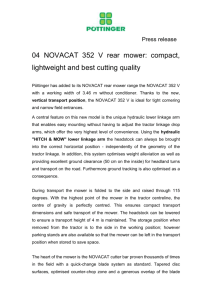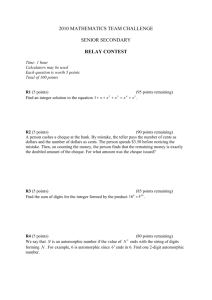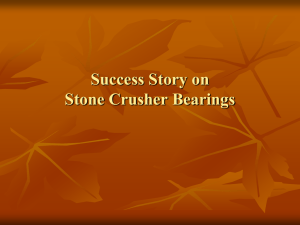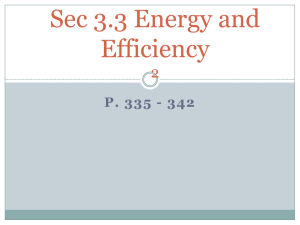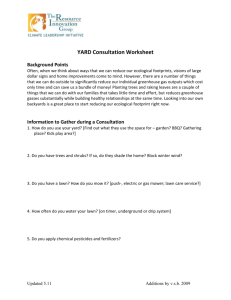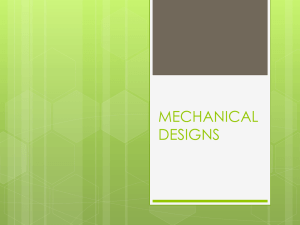DRIVE ASSEMBLY REPAIR
advertisement
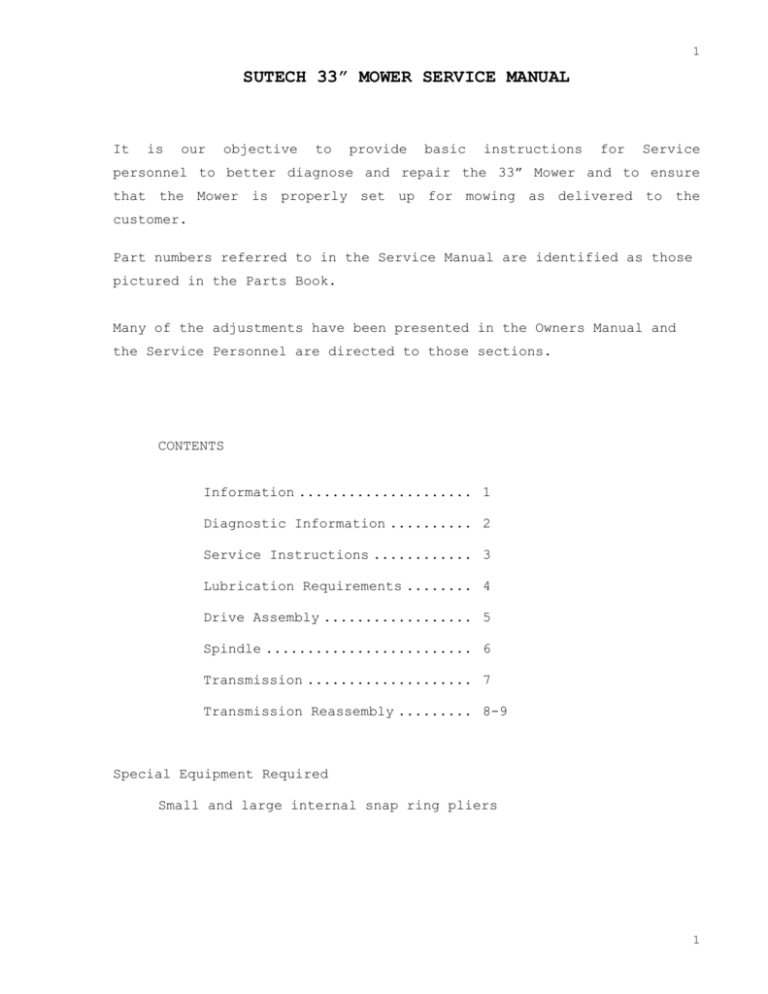
1 SUTECH 33” MOWER SERVICE MANUAL It is our objective to provide basic instructions for Service personnel to better diagnose and repair the 33” Mower and to ensure that the Mower is properly set up for mowing as delivered to the customer. Part numbers referred to in the Service Manual are identified as those pictured in the Parts Book. Many of the adjustments have been presented in the Owners Manual and the Service Personnel are directed to those sections. CONTENTS Information ..................... 1 Diagnostic Information .......... 2 Service Instructions ............ 3 Lubrication Requirements ........ 4 Drive Assembly .................. 5 Spindle ......................... 6 Transmission .................... 7 Transmission Reassembly ......... 8-9 Special Equipment Required Small and large internal snap ring pliers 1 2 SUTECH 33” MOWER SERVICE MANUAL DIAGNOSTIC INFORMATION We advise Service and Sales personnel to be looking for unusual operation when observing a Mower during operation either with the customer or trying to diagnose a problem with a Mower that has been returned by the customer for service. Most importantly look beyond the obvious broken parts to investigate what caused the problem, this will prevent future service calls. 1. Vibration could be caused by bent Mower Blades, bent Spindle Shafts, bent Engine Crankshaft, broken Pulleys or loose parts. 2. Frayed or broken belts usually caused by sharp edges on Pulleys, misalignment of Pulleys, harsh engagements by the operator, excessive heat due to slippages, impact loadings and sticks. 3. Structure and weld failures Look over the Mower for indication of structural cracks or any weld failures. caused by inadequate welds, excessive vibration or any May be operator abuse. 4. Pivot enlargement, Shaft and Bearing failures Inspect Bearings for noisy operation and rough turning, by spinning the component, looking at the Bearing surface for excessive wear, look for Seal failure in Bearings and lack of lubrication. 5. Improper cutting Look for dull Blades, drive Belt problems, loose or improperly incorrect adjusted front-to-back Belts Blade and Pulleys, broken plane setting, front Springs, of Blades should be set ¼” lower that the back of the Blades. Cutting in grass and weeds that is too tall or wet. 6. Mulching Operation will give the best results if the grass is dry and you are not cutting more than 1” – 1½”. Keeping the underside of the deck clean will improve air flow and mulching results. Additional mulching performance can be achieved by replacing the standard blades with optional P/N 2107/10 Mulching Blades available from your dealer. 2 3 BASIC SERVICE INSTRUCTION 1. Try to determine the cause of the problem under investigation and develop a plan of action to repair the problem in the most efficient way and in the least amount of shop or field service time. 2. It is possible to replace many of the parts or repair the major assemblies without fully removing them from the Mower. If possible try to minimize complete disassembly of all parts thus reducing the amount of repair time 3. When servicing the Mower, always try to select a work area that is free of debris and that that any oil or grease has been removed from the floor. 4. If possible, place the Mower on a stand and raise and securely block the tires to prevent the Mower from falling or rolling off the work minimizes surface. bending Try over placing where the repairs Mower can at be a made height in a that more comfortable position. 5. Use safety glasses when repairing the Mower and be careful, as sharp edges may be present. 6. Use the following guidelines for tightening bolts and screws. Over tightening hardware may cause subsequent failure to a Mower component when the customer or another person is operating the Mower. Bolt size Torque, ft lbs 12-24 2-3 ¼-20 7-11 5/16-18 15-22 3/8-16 30-40 7/16-20 50-60 LUBRICATION REQUIREMENTS 3 4 All parts that require lubrication have been lubricated during assembly. These parts will however require additional periodic lubrication for maximum mower life and safe operation. Grease points should be lubricated every 25-30 hours and oil points every 35-40 hours or yearly under normal operating conditions. Commercial use or extreme conditions will require shorter lubrication intervals. Grease Oil Any good quality Lithium based grease Differential (2 grease fittings) Blades Spindles (3 grease fittings) Blade Break (1 grease fitting) Front wheels & yokes (4 grease fittings) Any good quality SAE 30 oil Belt Guide Rollers (2 under belt cover) Pivot Point on all operational controls (breaks, shift lever, blade driver lever and presence controls) Transmission oil – check level in sight glass – add if required. Caster Yoke Height Adjustment Spacers Mower Storage For extended storage we recommend the use of a good quality fuel stabilizer to prevent starting problems. DRIVE ASSEMBLY REPAIR 4 5 To access or remove the Differential and Drive Assembly follow the instructions on page 6 of the Owners Manual for replacing the Wheel Drive Belt, items 1-8, Fig 9 & 10 and remove the hangers and brake assemblies from both sides of the Mower. Part numbers referred to are identified in the Parts Book on pages 7 & 8, DRIVE. It is possible to replace many of the Differential, Gearing, Bearings and other drive parts without fully removing the complete drive. If possible try to minimize complete disassembly of all parts. If possible leave the Brake parts together on the Hanger. Place the Mower on a stand and raise and securely block up rear Mower frame so tires clear the work surface. 1. Remove the 4 Wheel Lug Nuts 123 and Tire and Rim Assembly 101. Remove bolt 21 and FW 100 (Bolt may have Loctite), tap the Wheel Hub 102 and slide off, remove Square Key 121. In some cases the Wheel Hub may be difficult to remove. 2. Remove Snap Ring 240, Axle Hangers 110 or 131 can now be removed-will need to tap off the Shaft because the Bearings will be lightly pressed on the Axle Shaft 122, also remove Hanger 113. Be sure to identify orientation of all the Hangers for proper reinstallation. 3. Removing Snap Ring 107 allows Bearings 108 and Spacer 109 to be removed and replaced. 4. Remove 4 Bolts 118 and pull apart 119 & 129 Differential Axle Covers to gain access for inspecting and replacing Bevel Gears 124 and 127, Bearings, Axle Shafts and other internal parts. 5. During reassembly, be sure any foreign materials and broken parts are removed that all parts are thoroughly cleaned, greased where required and that 5 6 Bearings are pressed in squarely and properly aligned. Fill Differential Housing cavity with a high quality Lithium base grease. Reassemble all parts in reverse order, tighten bolts to torque specifications contained on page 1. Replacing parts on the LH side is similar to the RH side, except Snap Ring 114 must be removed to replace the Differential Pulley 115. Use a brass bar to remove pressed on parts. Hammering with steel will raise burrs and make reassembly difficult or impossible. SPINDLE REPAIR The Belt Cover must be removed to access the Spindles. Follow instructions on pages 4 & 5 of the Owners Manual for loosening all Belts. Spindle Housings and Spindles become damaged when the Mower Blades hit large objects. Bearings fail due to lack of periodic greasing and from dirt entering the Bearing. Following a good greasing schedule will tend to flush the Bearings of dirt and keep them clean. Part numbers referred to are identified in the Parts Book on pages 5 & 6, MOWER DECK. 1. Remove Nut 15 and the Bolt 48 for the outer Spindles and Bolt 49 for the Center Spindle to remove the respective Mower Blade parts. These three Bolts are Grade 8. CAUTION: Always replace these Bolts with the Approved SUTECH replacement parts. 2. For LH Spindle Service, carefully disengage the Blade Brake Spring and move the mechanism out of the way. Remove the Blade Drive Pulley 17. Brake 3. Remove the 4 bolts/nuts 21 & 31 attaching the Spindle Housing to the Mower Deck. 4. Degrease and clean the debris from the Spindle Assembly. 5. Remove Snap Ring 35 and Press Bearings 36 out top of Spindle Housing 40. 6. Remove Sq Keys 37, 39 or 42 to press off Spindle Bearings 36. Check to see that the Blade Spindle is not bent or damaged. 7. Thoroughly clean and replace any damaged parts and reassemble. Fill grease cavity with a high quality lithium base grease. Reinstall all parts; see Fig 5 for proper mounting order of the Blade and associated parts. Follow instructions outlined in the Owners Manual for proper V-Belt installation and Controls adjustments. 6 7 TRANSMISSION REPAIR The Transmission is serviceable and can be repaired by following proper procedures. In some cases where inspections need to be performed to diagnose a problem, they can be done without completely removing the Transmission from the Mower. It is recommended to pressure wash the Transmission to remove accumulated dirt and oil. Refer to pages 9 & 10 of the Parts Book, TRANSMISSION. 1. For the Manual start Mowers, remove the Transmission cover to gain access to the Transmission. 2. For the Electric start Mowers, disconnect the cables, and remove the Battery and its Supports to gain access. 3. Remove the two Wheel Drive Belts 202 from the Pulley. 4. Remove the Oil Sight plug 348 and drain the oil, use care not to damage the plug. Remove the Shift Lever 301 & 302. 5. Remove the RH & LH Bearing Covers 317, 328 & 339. USE a thin putty knife or thin Bladed screwdriver to loosen the cover and work the covers outward. The Seal Rings 318 and 329 will probably be damaged upon disassembly and should not be reused. Measure the thickness of the Seal Rings used on all four Bearing Covers. This will give a guide as to the correct seal thickness to select upon reassembly. 6. Remove all six Bolts 304 & 307 holding the Transmission covers together. Be careful where and how you tap the cover to lift it up off the roll pins. The Aluminum sealing and bearing surfaces are easily damaged. The Detent Steel Ball 309 may fall into the Bottom Transmission Case; use a magnet to retrieve the Ball. Remove Pulley 204 on the Output Shaft 332, LH side of the Transmission. 7. Most all of the internal components are serviceable at this point. Further inspection will determine what parts need replacing. Thoroughly inspect all Bearings for rough running and damaged sides. Inspect all Gearing for damaged faces especially if some teeth have broken. Replace all damaged parts. 7 8 8. If the Input Pinion Shaft Gear 340 is damaged then it must be removed out the bottom of the Case. Access can be gained by removing the Transmission Drive Belt 207 and Transmission Input pulley 209. Refer to the Owners Manual Fig 8 page 6. Remove the 4 Phillips head Screws 316 and Bearing Cover 346 as outlined above. From inside the Bottom Case tap the Input Pinion Shaft 340 Bearing and Seal set out. 9. Clean all parts and remove any foreign material from the bottom Case. Clean the mating faces of the Case halves, Sutech will have applied a liquid sealing compound. REASSEMBLY OF THE TRANSMISSION Care must be taken in the reassembly of the Transmission to insure that all Gears mesh properly and that the Shafts turn freely without being noisy. 1. If the Input Pinion 340 has been removed, then it must be reinstalled first. Press in place and install all components with a new Seal Washer 345. Refer to measuring procedure in paragraph 4 below for selecting the proper Seal thickness. 2. Install the Gear set, Washers and Bearings on the Output Shaft assembly, place the Shift Fork 312 around the Shift Collar 331 and lower the assembly into the Bottom Case, align the Shift Fork 312 in its bottom pivot hole. Center the Bearings in the Housing. Be sure that the Shift Rollers 314 stay in place on the Shift Fork. 3. Install all the Gears on the Countershaft press the Bearings tight against the shoulders and set the assembly in place, be sure to mesh the Spur Gearing. Lightly tap the Gear and Bearing set to move it left or right to obtain free movement of the Tapered Ring Gear. At least 0.015" rotational clearance MUST be present for proper Input Pinion and Tapered Gear mesh. 4. Use a micrometer to measure the distance between the outside of the case and the Bearing face, approximately 0.250 to 0.275" on both ends of the Countershaft, the Output Shaft and the Input Shaft assemblies-Record this data for each location. 5. Hold the Shafts in place and rotate the Input Shaft to verify proper Gear meshing. Use a wrench to move the Shift Collar to verify that shifting is free as the Input Shaft is rotated. 8 9 5. Clean the mating faces of the Case halves and apply Loctite sealant No. 587 to the Bottom Case. Do not put any sealant on the Bearing bores. 6. Install the Detent Spring 310 in the Ball Socket 311 and place some grease on top of the Detent Spring 310. Put the Detent Ball 309 on the Spring in the grease and lower the Top Case 308 onto the Bottom Case. Align the Shift Fork with its opening in the Top Case, lower and align the Roll Pins, carefully push the Case halves together without disturbing the Detent Ball. 7. Install the Shift Lever and while holding the halves together turn the Input Shaft and select each shift position. 8. Rotate the Input Shaft to recheck that 0.015" rotational clearance is present with the Tapered Ring Gear. 9. Install the 6 screws 304 & 307 and tighten. Do not over tighten two center Bolts that screw into the aluminum case—doing so will strip the threads. 10. Select thickness of the Seal washer: Using the depth measured in par. 3 above subtract that value from 0.290. Example: depth is 0.270, then washer thickness is .290-.270 = 0.020". Do this for each end of both Shafts. SUTECH offers three Seal Washers: .006”, .012” and .020” thickness. 11. Install the 4 screws 316 for each Bearing Cover, install the appropriate Seal and tighten. Rotate the input Shaft to be sure if rotates freely and that no binding exists. 12. Reinstall all parts removed during the service work in reverse order. 13. Operate the Mower to see that proper running is obtained. 9

